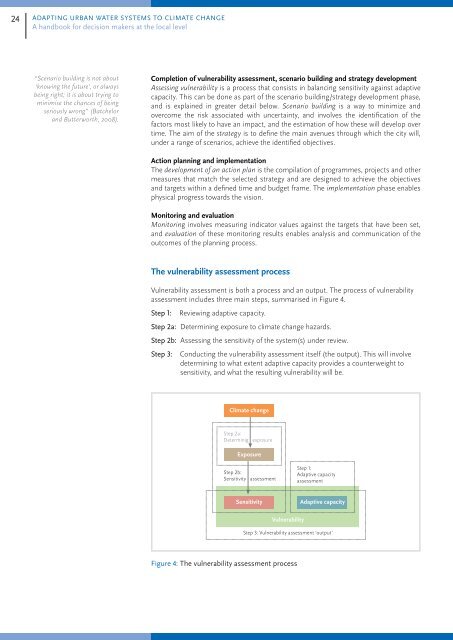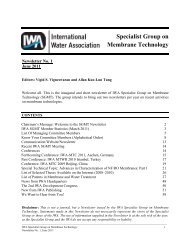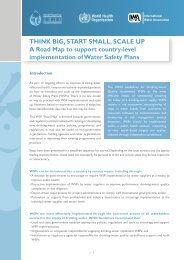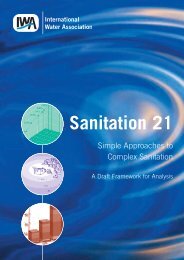AdApting urbAn wAter systems to climAte chAnge - IWA
AdApting urbAn wAter systems to climAte chAnge - IWA
AdApting urbAn wAter systems to climAte chAnge - IWA
Create successful ePaper yourself
Turn your PDF publications into a flip-book with our unique Google optimized e-Paper software.
24 Adapting urban water <strong>systems</strong> <strong>to</strong> climate change<br />
A handbook for decision makers at the local level<br />
Section 2<br />
A strategic planning framework for adaptation<br />
25<br />
“Scenario building is not about<br />
‘knowing the future’, or always<br />
being right; it is about trying <strong>to</strong><br />
minimise the chances of being<br />
seriously wrong” (Batchelor<br />
and Butterworth, 2008).<br />
Completion of vulnerability assessment, scenario building and strategy development<br />
Assessing vulnerability is a process that consists in balancing sensitivity against adaptive<br />
capacity. This can be done as part of the scenario building/strategy development phase,<br />
and is explained in greater detail below. Scenario building is a way <strong>to</strong> minimize and<br />
overcome the risk associated with uncertainty, and involves the identification of the<br />
fac<strong>to</strong>rs most likely <strong>to</strong> have an impact, and the estimation of how these will develop over<br />
time. The aim of the strategy is <strong>to</strong> define the main avenues through which the city will,<br />
under a range of scenarios, achieve the identified objectives.<br />
Action planning and implementation<br />
The development of an action plan is the compilation of programmes, projects and other<br />
measures that match the selected strategy and are designed <strong>to</strong> achieve the objectives<br />
and targets within a defined time and budget frame. The implementation phase enables<br />
physical progress <strong>to</strong>wards the vision.<br />
Moni<strong>to</strong>ring and evaluation<br />
Moni<strong>to</strong>ring involves measuring indica<strong>to</strong>r values against the targets that have been set,<br />
and evaluation of these moni<strong>to</strong>ring results enables analysis and communication of the<br />
outcomes of the planning process.<br />
The vulnerability assessment process<br />
Vulnerability assessment is both a process and an output. The process of vulnerability<br />
assessment includes three main steps, summarised in Figure 4.<br />
Step 1: Reviewing adaptive capacity.<br />
Step 2a: Determining exposure <strong>to</strong> climate change hazards.<br />
Step 2b: Assessing the sensitivity of the system(s) under review.<br />
Step 3: Conducting the vulnerability assessment itself (the output). This will involve<br />
determining <strong>to</strong> what extent adaptive capacity provides a counterweight <strong>to</strong><br />
sensitivity, and what the resulting vulnerability will be.<br />
Climate change<br />
Step 1: Adaptive capacity assessment<br />
Determining the adaptive capacity of a system can be a complex, subjective and timeconsuming<br />
task; how thoroughly a city will be able <strong>to</strong> conduct its adaptive capacity<br />
assessment will therefore strongly depend on its resources. For the purposes of this<br />
handbook, a more in-depth approach following the logical principles of strategic planning<br />
is laid out, though a more rapid and targeted approach <strong>to</strong> such an assessment is also<br />
possible. In this case, a city or utility would seek <strong>to</strong> identify the features of adaptive capacity<br />
within a specific system that moderate its response <strong>to</strong> a given climate change hazard.<br />
An in-depth and holistic approach <strong>to</strong> adaptive capacity assessment, on the other hand,<br />
seeks <strong>to</strong> consider all of the determinants of adaptive capacity within a city that exist<br />
regardless of climate change. This ensures a more thorough approach is taken. Indeed,<br />
reviewing this ‘generic’ adaptive capacity means that the analysis will not be blinkered by<br />
any particular expected hazard and is likely <strong>to</strong> produce more wide-ranging results that<br />
take in<strong>to</strong> account the links between urban sec<strong>to</strong>rs. Moreover, knowing the general state<br />
of adaptive capacity for the urban area under consideration means that vulnerability <strong>to</strong><br />
all types of hazards can more easily be identified, which is particularly important in the<br />
context of uncertain and imprecise climate change predictions. The flip side of this is that<br />
assessment of generic adaptive capacity is more time-consuming and complex.<br />
A typical approach <strong>to</strong> adaptive capacity assessment involves the selection of proxy<br />
indica<strong>to</strong>rs that serve <strong>to</strong> evaluate adaptive capacity determinants. Annex 3 defines four<br />
categories of determinants (economy, society, governance and eco<strong>systems</strong>) and gives<br />
some examples of elements that can be looked at in conjunction with these categories,<br />
without aiming <strong>to</strong> provide a complete list or selecting indica<strong>to</strong>rs. For example, when<br />
looking at economic determinants of adaptive capacity, a city might want <strong>to</strong> think about<br />
economic development as one area of interest, and it could select for example GDP per<br />
capita and GDP growth rate as indica<strong>to</strong>rs with which <strong>to</strong> represent and quantify economic<br />
development.<br />
The selection and interpretation of indica<strong>to</strong>rs is not straightforward; it is location-specific,<br />
and should therefore be conducted locally (Schauser, Harvey, & Schneiderbauer, 2010).<br />
However, such an approach is still valuable as it is the most easy <strong>to</strong> apply and understand;<br />
it can greatly benefit from the involvement of stakeholders. In terms of interpretation for<br />
example, it is hard <strong>to</strong> evaluate the way in which values obtained against indica<strong>to</strong>rs affect<br />
adaptive capacity; e.g. what is the cut-off point for deciding whether an indica<strong>to</strong>r reveals<br />
high or low adaptive capacity<br />
Step 2a:<br />
Determinig exposure<br />
Exposure<br />
Step 2b:<br />
Sensitivity assessment<br />
Sensitivity<br />
Vulnerability<br />
Step 3: Vulnerability assessment ‘output’<br />
Figure 4: The vulnerability assessment process<br />
Step 1:<br />
Adaptive capacity<br />
assessment<br />
Adaptive capacity<br />
Step 2: Sensitivity assessment<br />
Step 2a: Assessing exposure<br />
Determining exposure forms a natural part of the scenario-building phase of the strategic<br />
planning process, since it involves determining what hazards the city will be exposed <strong>to</strong>.<br />
Exposure of a city <strong>to</strong> climate change hazards can be determined at different scales of<br />
precision, depending upon the city’s location and the resources that are available <strong>to</strong> it.<br />
Cities can rely upon predictions of climate change that have been made at the international<br />
level (the IPCC being the main source for these) or upon downscaled predictions that<br />
have been made at a continental, national, or even regional scale, if these exist (Kropp &<br />
Scholze, 2009). Such predictions can generally be accessed through the websites of the<br />
environmental or meteorological agencies of national or regional governments as well as<br />
those of research institutes. If a city has sufficient time, skills and financial resources, it<br />
may choose <strong>to</strong> do its own downscaling of climate models, using publicly available data.<br />
Collaboration with the research<br />
community can be particularly<br />
valuable for generating more<br />
locally-specific predictions; see<br />
the box on Learning Alliances<br />
in Section 2.2.
















